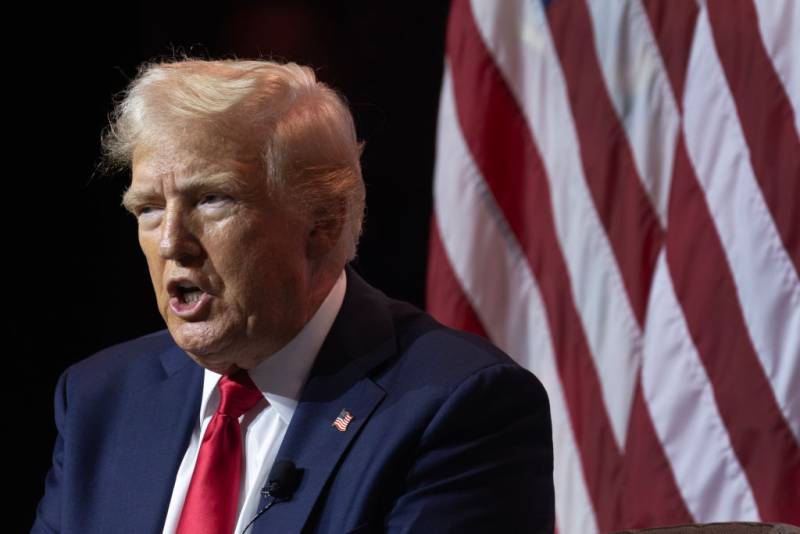“Project 2025,” the 900-page right-wing policy agenda by allies of former President Donald Trump, has entered the mainstream in the last month.
Despite Trump’s claims that he has nothing to do with the extensive document — authored by the conservative Heritage Foundation think tank — many of its authors and supporters are Trump allies, former and current Trump staffers and even his vice presidential pick. The lengthy treatise puts forth concrete plans for the next Republican administration to consolidate presidential power, sideline critics and implement an extreme religious-right social agenda.
It’s not just a policy agenda, though: The Heritage Foundation has also created a personnel database of pre-vetted conservatives who could serve in the next GOP administration; a training program to get potential personnel up to speed; and a secret plan for the first 180 days of a new Republican administration.
On Tuesday, Heritage announced that its director, Paul Gans, was stepping down but that Project 2025’s work would now instead be led by its president, Kevin Roberts. But what is in Project 2025, and how achievable are its aims?
KQED’s Political Breakdown podcast spoke to Philip Bump, national columnist for The Washington Post, to dig into Project 2025 as a right-wing “wish list,” why Trump keeps attempting to publicly disavow it, and how fast a second Trump administration could be able to enact such plans starting January 2025.
Keep reading for the takeaways from their conversation with Bump about Project 2025, or listen to the audio below (the Project 2025 conversation begins at 10:53.)
This interview has been edited for length and clarity.
There’s a reason Trump hasn’t provided many concrete presidential policy plans himself
Phillip Bump: Over the course of the Republican primary, especially before he really started to gain ground against Florida Gov. Ron DeSantis, Trump started to do these little videos articulating what they called Agenda 47: What he would do when he came back in office. And most of them were very responsive to whatever the hot issue on Fox News, and in the right, happened to be at the moment … all these really random things. [See Bump’s searchable tool for Agenda 47 for The Washington Post.]
But fundamentally … he doesn’t want to offer a lot of specifics. This is a guy whose career prior to becoming a politician was a salesman — and not only was he a salesman, he was a guy selling real estate in New York. Which is, you know, like selling used cars in Topeka. This is not someone whose track record of salesmanship is rooted in the most robust ethics.
And so he doesn’t want to commit. He wants to tell people what he wants to tell them in order to make the sale, and so that means being very vague. He frames this as being part of his art in negotiation. … But it’s really fundamentally about telling as few people as possible something they don’t want to hear so that he can maximize the number of people who might be receptive to his candidacy.
It benefits Trump to deny any association with Project 2025
First of all, I think it’s fundamentally dishonest. You can’t both say, “I know nothing about Project 2025” and “I disagree with some of its elements.” Like that doesn’t make sense, right? But it is about recognizing that Project 2025 establishes something for Democrats to point at — it says, “Here are the things that Donald Trump would do.” And it does so very credibly.
The Heritage Foundation, which put together Project 2025, did tap a lot of people from Trump World, in part because that’s the locus of power within the political right at this point in time. It has people like John McEntee, who was basically in charge of staffing at the tail end of the Trump administration. It has Russ Vought, who used to run [the U.S. Office of Management and Budget] and has been talked about as being potentially Trump’s chief of staff. And a number of other individuals who participated in Donald Trump’s administration and who are now saying, “Here’s what we think the government should do, should a conservative return to power in the White House” — which, of course, means should Donald Trump be elected in 2024 and take office in 2025.
So, for the Trump campaign, it is crucially urgent … to get people to think that Project 2025 is something else that isn’t theirs, isn’t what they want to do.
Trump’s campaign was not prepared for their 2016 win — but Project 2025 shows how they’d hit the ground running this time
I think that part of it is a response to the way in which Trump took power in 2017. It’s important to remember, of course, that no one expected Donald Trump to be taking the presidency. The polling up until the very end showed that he was likely to lose.
And then, of course, he took power, and he came into the White House with this amalgamation of both the establishment side of the GOP — Reince Priebus, who used to run the actual RNC, and then he had Steve Bannon, representing the fringe right on the other side. And he tried to mesh those things together, and he didn’t know what the balance of his power was, and he was concerned about reelection and all these aspects that were in place in 2017 that won’t be in 2025.
“We take a lot of exception with Joe Biden. But the one thing I do credit his team with was being prepared. So they were signing things all week long the first week, and we are going to be doing the same. We are now in the course of drafting these executive orders, and rethinking and identifying the stuff that needs to come down. We’re not going to wait and do this in the 90 days between the election. We’re going to be doing this as a team, as an entire movement years ahead.”
– Paul Gans, the now-departed director of the Heritage Foundation
So [Trump]’s returning to the White House, should he win the election this year, with a clearer sense of purpose — with a better understanding of where the boundaries are, with no concern about being reelected down the road. And with an entire movement already lined up behind him to affect the things that he wants to do.
Which, of course, are really the things that they want.
A major focus of Project 2025 is reshaping the federal government — quickly
Among [the 2025 plans] is this plan to very dramatically overhaul the federal government, to get rid of as many federal governments [sic] as they possibly can so that they can be replaced with Trump sympathizers. And to do so in the context of having already tested the limits and seeing where the limits don’t really exist, and seeing limits removed by the Supreme Court.
For a long time, the core focus of the political right was to unwind the power of government. And that has been reshaped in the Trump era to imbue a lot more power in the presidency for presidents who don’t carry a “D” on their ballot assignation.
Everyone, I think, recognizes that Donald Trump himself doesn’t care a whole lot about what policies are implemented. And so what they’re trying to do is get a big cadre of people together who do care about it, to give Donald Trump the mechanism to actually overhaul as much of the government as possible and then put these people in.
Project 2025 is about things like identifying who can move into these positions, who should be hired, who can serve in cabinet positions, but who can also serve in government agencies. And there is a training program that is for people who are interested in coming and learning about the ideals that the Heritage Foundation and Project 2025 are trying to have government employees arrive in D.C. with.
It is this broad effort to overhaul the government — in a way that it is responsive to the will of the president.

When it comes to removing government workers in 2025, there aren’t as many guardrails as you’d think
Trump tried to do this at the tail end of his presidency and introduce a new category for federal officials called Schedule F, which would make it easier to fire a number of people. He tried to implement that. It didn’t take hold.
Biden reversed the decision, came into office, and then tried to put in some roadblocks to keep doing that. But there really is broad power that [Trump]’s got to effect the changes, the bureaucracies he wants to see.
He’s also, of course, empowered by a Supreme Court that has shown a lot of deference to the worldview that Donald Trump represents. I mean, if this comes down to a fight at the Supreme Court between federal employees and Donald Trump in terms of where power should lie, it’s pretty obvious where the Supreme Court’s going to land.
Project 2025 is a wishlist that goes beyond reshaping government
I think it’s important to recognize, too, that when we talk about this, it’s sort of a wish list that the people who, for a long time, have been frustrated with particular aspects of the federal government are happy to put down on paper. “Oh, well, we should get rid of this agency or that agency,” and so on and so forth. There’s a lot of that sort of thing that exists in Project 2025, or at least in this 900-page document.
There’s also a lot of social issues: things like overhauling the ways in which people can be charged with crimes for alleged voter fraud; things that are responsive to Donald Trump’s efforts to try and claim that the 2020 election was stolen. There are changes, potentially, in the ways in which divorce is handled in the United States.
It is really a wish list of: if you have heard a conservative or a Republican say, “Hey, wouldn’t it be great if?” over the course of the past 20 years, the odds are good that they got someone to write up 300 words and put it in this document explaining why this should be part of the next administration.

